9th century
This articleneeds additional citations forverification.(January 2017) |
| Millennium |
|---|
| 1st millennium |
| Centuries |
| Timelines |
| State leaders |
| Decades |
| Categories: |
|
Births–Deaths Establishments–Disestablishments |
The9th centurywas a period from801(represented by theRoman numeralsDCCCI) through900(CM) in accordance with theJulian calendar.
TheCarolingian Renaissanceand theViking raidsoccurred within this period. In the Middle East, theHouse of Wisdomwas founded inAbbasidBaghdad,attracting many scholars to the city. The field ofalgebrawas founded by the Muslim polymathal-Khwarizmi.The most famous Islamic scholarAhmad ibn Hanbalwas tortured andimprisonedby Abbasid officialAhmad ibn Abi Du'adduring the reign of Abbasid caliphal-Mu'tasimand caliphal-Wathiq.In Southeast Asia, the height of theMataram Kingdomhappened in this century, while Burma would see the establishment of the major kingdom ofPagan.Tang Chinastarted the century with the effective rule underEmperor Xianzongand ended the century with theHuang Chao rebellions.In America, theMayaexperienced widespreadpolitical collapsein the central Maya region, resulting ininternecine warfare,the abandonment of cities, and a northward shift of population.
West Africa[edit]
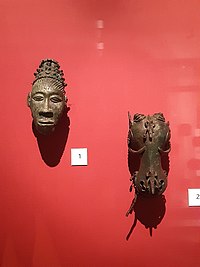
Southeastern Nigeria[edit]
Around the 9th century, theIgbo peopleof what is now southernNigeriadeveloped bronze casts ofhumans,animals,andlegendary creatures.These bronzes, which were used as vessels, amulets, pendants, and sacrificial tools, are among the earliest made bronzes ever found in Nigeria. Most items were part of a burial of a nobleman culture in the northern part of theIgboland.
Ghana Empire[edit]
TheGhana (Wagadu) Empire(beforec. 830untilc. 1235) was located in what is now southeasternMauritaniaand westernMali.It is considered the first of theSahelian Kingdoms,which would exist in some form until the early 20th century.
Western Europe[edit]
Britain and Ireland[edit]
Britainexperienced a great influx ofVikingpeoples in the 9th century as theViking Agecontinued from the previous century. The kingdoms of theHeptarchywere gradually conquered by the Danes, who set up Anglo-Saxon puppet rulers in each kingdom. This invasion was achieved by a huge military force known as theGreat Heathen Army,which was supposedly led byIvar the Boneless,Halfdan Ragnarsson,andGuthrum.This Danish army first arrived in Britain in865inEast Anglia.After conquering that kingdom, the army proceeded to capture the city ofYork(Jorvik) and establish the kingdom ofJorvik.The Danes went on to subjugate the kingdom ofNorthumbriaand to take all but the western portion ofMercia.The remaining kingdom ofWessexwas the only kingdom of theHeptarchyleft.Alfred the Greatmanaged to maintain his kingdom ofWessexand push back the Viking incursions, relieving the neighbouring kingdoms from the threat of the Danes following his famous victory over them at theBattle of Ethandunin878.Alfred re-establishedAnglo-Saxonrule over the western half ofMercia,and theDanelawwas established which separatedMerciainto halves, the eastern half remaining under the control of the Danes.
Irelandwas also affected by the Viking expansion across theNorth Sea.Extensive raids were carried out all along the coast and eventually, permanent settlements were established, such as that ofDublinin841.Particular targets for these raids were the monasteries on the western coast of Ireland, as they provided a rich source for loot. On such raids theVikingsset up impermanent camps, which were calledlongphortsby the Irish—this period of Viking raids on the coasts of Ireland has been named the longphort phase after these types of settlements. Ireland in the 9th century was organised into an amalgam of small kingdoms, calledtuatha.These kingdoms were sometimes grouped together and ruled by a single, provincial ruler. If such a ruler could establish and maintain authority over a portion of these tuatha, he was sometimes granted the title ofHigh King.
Scotlandalso experienced significant Viking incursions during the 9th century. The Vikings established themselves in coastal regions, usually in northern Scotland, and in the northern islands such asOrkneyandShetland.The Viking invasion and settlement in Scotland provided a contributing factor in the collapse of the kingdoms of thePicts,who inhabited most of Scotland at the time. Not only were the Pictish realms either destroyed or severely weakened, the Viking invasion and settlements may have been the reason for the movement ofKenneth MacAlpin,the king ofDál Riataat that time. The kingdom ofDál Riatawas located on the western coast of Scotland, and Viking incursions destroyed it after the death of its previous king,Áed mac Boantain 839, according to theAnnals of Ulster.This may have caused the new king, MacAlpin, to move to the east, and conquer the remnants of the Pictish realms. MacAlpin became king of the Picts in 843 and later kings would be titled as theKing of AlbaorKing of Scots.
Art[edit]
Art in the 9th century was primarily dedicated to the Gospel and employed as basic tools of liturgy of the Roman Orthodox Church. Thousands of golden art objects were made: Sacred cups, vessels, reliquaries, crucifixes, rosaries, altarpieces, and statues of the Virgin and Child or Saints all kept the flame of western art from dying out. Architecture began to revive to some extent in the West by the 9th century, taking the form of Church facilities of all kinds, and the first castle fortifications since Roman times began to take form in simple "moat and bailey" castles, or simple "strong point" tower structures, with little refinement.
Events[edit]

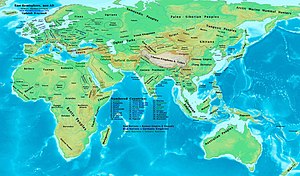
- 800s:Southeast Asiankingdoms of Muja (then paganBrunei/Vijayapura) and Mayd (Ma-i) waged war against the Chinese Empire.[2]
- 802:Jayavarman IIof theKhmer peopleinCambodiafounds theKhmer empireand establishes the Angkorian dynasty.
- 803:Construction on theLeshan Giant BuddhainTang dynastyChinais complete, after 90 years of rock-carving on a massive cliff-side.
- 805–820:Tang dynastywas under the rule ofEmperor Xianzong of Tang.
- 809–815:War between theByzantine empireandBulgaria.
- 811:Battle of Pliskafought between a Byzantine force led by emperorNicephorus Iand aBulgarianarmy commanded by KhanKrum.Byzantines are defeated in a series of engagements, culminating with the death ofNicephorus I.
- 813:Byzantines are heavily defeated by the Bulgars at Versinikia.
- 813:China is reunited.[clarification needed]
- c.813– c.915:Period of serious Arab naval raids on shores of Tyrrhenian and Adriatic seas.
- 814:Charlemagnedies in the city ofAachen.
- 815:A30-year peace agreementis signed between Bulgaria and the Byzantine Empire.
- 820:Muḥammad ibn Mūsā al-Khwārizmīwrites his treatise on AlgebraThe Compendious Book on Calculation by Completion and Balancing.
- 824:Han Yudies.
- 825:Battle of Ellandun:King Egbert of Wessex defeats Mercia and establishes the kingdom of Wessex as the supreme Kingdom in England.
- 825:Borobuduris completed during the reign ofSamaratungga.[3][4]
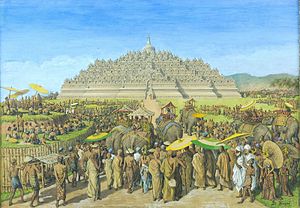
- 827–902:Aghlabidsestablished emirate (province) inSicilyand subsequently raids Southern Italy.
- 830:TheGhana (Wagadu) Empireis established.
- 830:TheHouse of Wisdom,a library and translation institute established inBaghdadbyal-Ma'mun,Abbasidcaliph,to transfer the knowledge of Greeks, Persians, Indians, etc. to the Muslim world.The Compendious Book on Calculation by Completion and Balancing,a book ofalgebra,is also written there byAl-Khwarizmi.
- 835:Sweet Dew Incidentoccurs.Emperor Wenzongof theTang dynastyconspires to kill the powerfuleunuchsof the Tang court, but the plot is foiled.
- 839–842:Vlastimir defeats Presian.
- 840:Death ofLouis the Pious.
- 841:Dublinis founded on the east coast of Ireland by theVikings.
- 842:Samaale becomes chief of the Hashiyah clan and launches the conquest of Somalia. This paves the way for Hashiyic colonisation of the Peninsular, displacing the native Cushitic peoples of Somalia
- 843:The Carolingian Empire is at its height in territory and area.[7]The three sons ofLouis the Piousreach an agreement known as theTreaty of Verdunand split theCarolingian empireinto three divisions;East Franciawas given toLouis the German,West FranciatoCharles the BaldandMiddle FranciatoLothair I.
- 844:The first Viking raid in Iberia
- 845:Buddhismis persecuted and banned in China.
- 846–859:Emperor Xuānzong of Tangreigned. He was considered[by whom?]the last capable emperor of theTang dynasty.
- 846:11,000SaracenArab squadrons from Africa, with 500 horses, desecrateChristianshrines inRome,including the tombs and basilicas of Sts. Peter and Paul.
- 848–852:The west bank of theTiberis annexed into the city ofRome.Adefensive wall,commissioned byPope Leo IV,is built around what came to be called theLeonine Cityas a defensive response to theSaracendesecration ofRomein846.
- 850–875:The firstNorse settlersarrive onIceland.
- 850s:TheMuslimBerberdynastyBanu Isamis founded inCeuta.
- 851:The Arab merchantSulaiman al-Tajirvisits the ChineseseaportatGuangzhouin southern China, and observes the manufacturing ofporcelain,the Islamicmosquebuilt at Guangzhou, thegranarysystem of the city, and how itsmunicipaladministration functioned.
- 856:Prambananis completed.[8]According to theShivagrha inscription,Rakai Pikatan— the husband ofPramodhawardhani— defeatedBalaputra.
- 859:Muslims establish theUniversity of Al Karaouineas amadrasainFez, Morocco.
- 860:Balaputra,the maharaja ofSuvarnadvipaand the ruler of Srivijaya, constructs the Buddhist temple and monastery inNalandaIndia,on the land given by King Devapaladeva. of Pala in Benggala, according to theNalanda inscription.[9]
- 861:Assassination ofAbbasidcaliphal-Mutawakkil(r. 847–861) and decline of theAbbasid Caliphate.
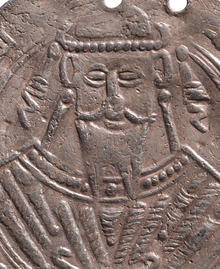
Coin issued duringal-Mutawakkil's reign in the mid-9th century - 862:The beginning of theRurik dynastyinRus'.
- 863:The Chinese authorDuan Chengshidescribes theslave trade,ivory trade,andambergristrade ofSomaliainEast Africa.
- 862:TheBagratuni dynastyofMedieval Armeniabegins withAshot I.
- 863–879:Period of schismbetween Eastern and Western churches.
- 864:Christianization of BulgariaunderBoris I
- 867:Onward revival of theByzantine Empireunder theMacedonian dynasty.
- 868:Ahmad ibn Tulunbreaks away from theAbbasid Caliphateand establishes the independentTuluniddynasty.
- 869:Anearthquake and tsunamistruckJapan'sSanriku coast,killing 1,000 people.
- 869–883:Zanj Rebellionagainst theAbbasids
- 870:Christianization of the Serbs.
- 870:Prague Castlefounded.
- 871–899:Reign ofAlfred the Great,the first king of the English.
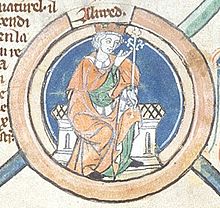
Alfred the Great ledWessexat its height in the 9th century - 872:Icelandsettled byIngolfur ArnarsonfromNorway.
- 875–884:Huang Chaoleads an unsuccessful rebellion against theTang dynastyin China.
- 878:Battle of Ethandunresults in the victory ofAlfred the Greatover the Danish warlordGuthrum.
- 885:Arrival of the disciples ofSaints Cyril and Methodius,Clement of OhridandNaum of Preslavin Bulgaria. Development of theCyrillic Alphabet.
- 885:Abbo Cernuusbecomes witness to theSiege of Parisby Vikings.[10]
- 888:TheCarolingian Empiredeclines and falls after the death ofCharles the Fat.
- 893:Council of Preslav-Vladimir-Rasateis dethroned and succeeded as Prince of Bulgaria bySimeon I;the capital is moved fromPliskatoPreslav;the Byzantine clergy is expelled and replaced by Bulgarian;Old Bulgarianbecomes the official language of the country.
- 895/896:The year of theMagyarsarrival inPannonia.This year is widely accepted as the beginning of the Hungarian "Landtaking".
- 899:King Alfred the Great of Wessex, First King of The English, dies.
- 900:The oldest text discovered in thePhilippines—an acquittance document inOld Javanese—is inscribed on a copperplate inLuzon.The acquittance took place on 21 April 900[11]and involved several aristocrats and high-ranking officials from kingdoms within the islands of Luzon, Mindanao, and Java. The document is currently called theLaguna copperplate inscription.
- Late 9th century:Bulgariastretches from the mouth of theDanubetoEpirusandBosnia.
- Late 9th century:Pallava dynastyends inSouthern India.
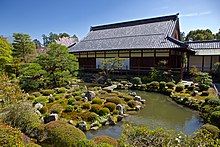
To-ji in Kyoto, completed in the late 9th century - Late 9th century: Womb World mandala,To-ji,Kyoto,is made.Heian period.
Unknown date[edit]
- Reign ofCharlemagne,and concurrent (and controversially labeled)Carolingian Renaissancein Western Europe.
- An unknown event causes thedeclineof theMaya Classical Era.
- Beowulfmight have been written down in this century; alternatively, it could also have been in the 8th century.
- Large-scaleVikingattacks on Europe begin, devastating countless numbers of people.
- Osebergship burial.
- TheMagyarsbegin their conquest ofPannonia(roughly modern-dayHungary), a process that will take several decades to be completed.
- TheTukolorsettle in theSenegalriver valley.
- Muslimtraders settle in the northwest and southeast ofMadagascar.
- InItaly,some cities became free republics: for instanceForlì,in889.
- The ChristianNubiankingdom reaches its peak of prosperity and military power. (Early history of Sudan).
- Harald Fairhairwas victorious at theBattle of Hafrsfjord,andNorwaywas unified into one kingdom.
- TheMedieval Warm Periodbegins.
- TheCoptic period,at its most broad definition, ends.
- Page fromKoran(Surah II:286 and titleSurah III) inkuficscript, fromSyria,is made. Now kept at TheMetropolitan Museum of Art,New York.
Inventions, discoveries, introductions[edit]
- AlgebrabyAl-Khwarizmi
- Quadratic equations:Indian mathematician Śrīdharācāryaderived the quadratic formula used for solving quadratic equations.
- First image of a rotary grindstone in a European source—illustration shows crank, first known use of a crank in the West (Utrecht Psalter,843)
- First known printed book, theDiamond Sutra,printed in China usingwoodblock printingin 868.
- Invention ofgunpowderby ChineseTaoistAlchemists.
- ChessreachesJapan.
- Vulgar Latinbegins to develop into variousRomance languages.
- Two syllabaries orkanaare developed from simplified Chinese characters inJapan.
- TheTibetan Scripthad its third and last orthographical reform.
See also[edit]
References[edit]
- ^Apley, Alice."Igbo-Ukwu (ca. 9th century)".Metropolitan Museum of Art.Archivedfrom the original on 4 December 2008.Retrieved2008-11-23.
- ^Nicholl, Robert (1983)."Brunei Rediscovered: A Survey of Early Times".Journal of Southeast Asian Studies.14(1): 32–45.doi:10.1017/S0022463400008973.ISSN0022-4634.JSTOR20174317.S2CID161541098.
- ^abDumarçay (1991).
- ^abPaul Michel Munoz (2007).Early Kingdoms of the Indonesian Archipelago and the Malay Peninsula.Singapore: Didier Millet. p. 143.ISBN978-981-4155-67-0.
- ^Soekmono (1976), page 9.
- ^Miksic (1990)
- ^"Succession of the Carolingian Empire, 843 CE".Cmunce.org.Columbia Model United Nations Conference and Exposition. Archived fromthe originalon 25 December 2014.Retrieved24 December2014.
The year is 843 C.E., and the Carolingian Empire has reached the peak of its expansion, covering more territory in Western Europe than any other dynasty since the Roman Empire.
- ^Miksic(1997)
- ^Soekmono, R, Drs., Pengantar Sejarah Kebudayaan Indonesia 2, 2nd ed. Penerbit Kanisius, Yogyakarta, 1973, 5th reprint edition in 1988 p.46
- ^Jones, Colin (2006-04-06).Paris: Biography of a City.Penguin Adult. p. 32.ISBN978-0-14-028292-4.
- ^Julian equivalent of the indicated Hindu calendar date: the 4th day, aMonday,of thedarkening halfof the monthVaisakhainShaka year822
Bibliography[edit]
- Comans, Michael (2000),The Method of Early Advaita Vedānta: A Study of Gauḍapāda, Śaṅkara, Sureśvara, and Padmapāda,Delhi: Motilal Banarsidass
- Sharma, Chandradhar (1962).Indian Philosophy: A Critical Survey.New York: Barnes & Noble.
